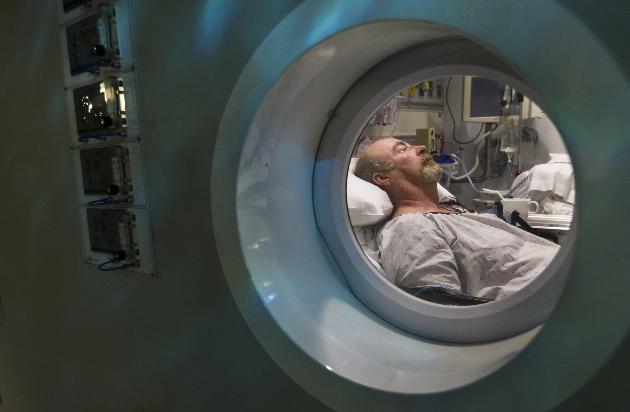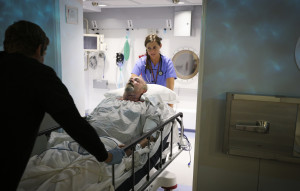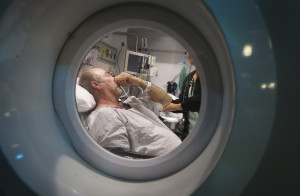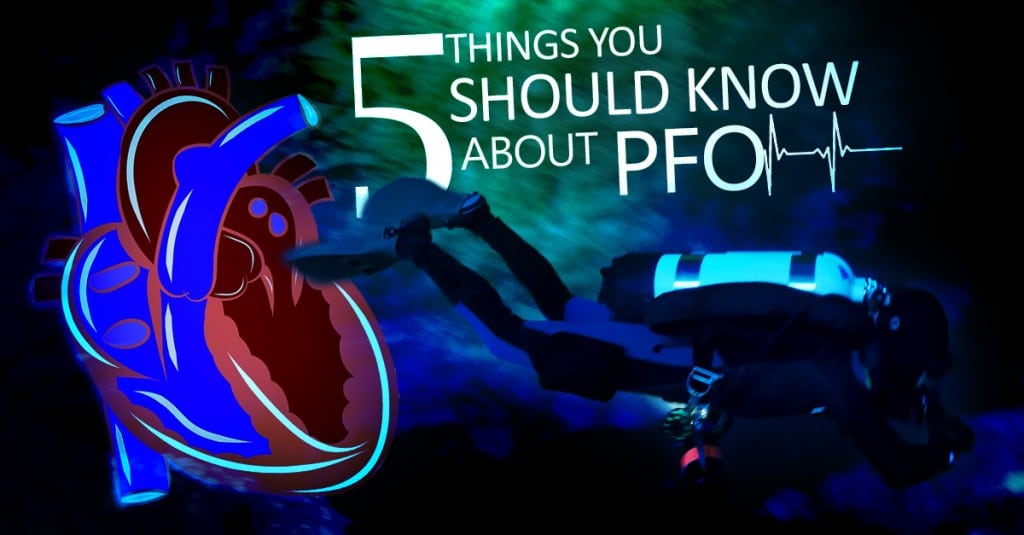News
Record 53 hour session in hyperbaric chamber saves diver’s life

Thanks to some quick thinking by doctors and a handy US Navy Diving manual, a recent record breaking long-haul stay in a hyperbaric chamber saved the life of a Michigan diver…
“What I was worried about the most was holding my breath if I panicked,” said 64-year-old Begnoche, as holding your breath while ascending rapidly could cause a fatal lung embolism. “Panic is what really kills people.”
Last month Begnoche and other volunteers dived a shipwreck to capture footage off the coast of Grand Marais, Michigan. After he was pulled onto the boat, he started feeling prickly sensations in his body and he lost control of his arms and legs. His rapid ascent caused nitrogen bubbles to form in his bloodstream, cutting off blood to his spinal cord and other parts of his body.
 His decompression sickness was so severe that saving Begnoche required a helicopter rescue to Marquette, Michigan and then a low-altitude flight to Hennepin County Medical Center in Minneapolis, where doctors tried a rare treatment protocol which they found in the U.S. Navy’s Diving Manual.
His decompression sickness was so severe that saving Begnoche required a helicopter rescue to Marquette, Michigan and then a low-altitude flight to Hennepin County Medical Center in Minneapolis, where doctors tried a rare treatment protocol which they found in the U.S. Navy’s Diving Manual.
Along with a nurse, Begnoche spent a record 53 hours in HCMC’s hyperbaric chamber to give his body a chance to slowly clear out the damaging nitrogen bubbles.
“It’s really rare to have to do that protocol for a couple of reasons,” said Dr. Chris Logue, medical director of HCMC’s center for hyperbaric medicine. “One is that most people die. They never make it to treatment.”
Begnoche was like a “human soda bottle” that had been shaken up, Logue said, and caregivers needed to figure out how to deflate the bubbles.
Most of the time, HCMC’s hyperbaric chamber simulates a depth pressure of 45 feet to 60 feet below the surface and promotes healing by creating an oxygen-rich environment for patients suffering severe wounds or conditions such as anemia or carbon monoxide poisoning.
In this instance, Logue needed to simulate a depth of 165 feet — only 10 feet above the chamber’s maximum limit — to mimic Begnoche’s actual dive depth. That would drive the nitrogen in his body from bubbles into a solution and allow it to escape his body slowly and safely.
That’s what would have happened naturally if Begnoche ascended slowly from the lake as planned, with three or four decompression stops on the way to the surface.
Nurse Kimberlee Nerling, who was in the chamber with Begnoche the entire time, said she noticed immediate movement in the man’s arms when the chamber reached its maximum depth.
Begnoche has since regained control of his arms, and concerns about his lung functioning are over. But the semi-retired environmental manager and university lecturer can’t walk or move his legs yet.
 He is receiving additional daily treatments in the hyperbaric chamber in the hopes that they will stimulate healing and reduce inflammation in his spinal cord. Whether he will make a full recovery is, as yet, uncertain.
He is receiving additional daily treatments in the hyperbaric chamber in the hopes that they will stimulate healing and reduce inflammation in his spinal cord. Whether he will make a full recovery is, as yet, uncertain.
“It’s such a rare event, it’s impossible to tell,” Logue said. “What we’ve gained back, I’m thrilled about.”
Begnoche, who lives in Michigan, watched films during his two-plus days in the chamber. He struggled to sleep and replayed how the dive went wrong in his mind.
Loaded with underwater lighting and a video camera to examine the recently discovered Nelson, a three-masted schooner that sank off the coast of Grand Marais, Michigan in 1899, Begnoche had neglected to put on a weight that would have otherwise controlled his ascent. The project was part of his work with the Great Lakes Shipwreck Museum.
Given the amount of oxygen in his tank, he had only 20 minutes to spend by the ship. At 19 minutes, just to play it safe, he started to rise and pointed the video camera back down at the ship on the lake’s floor. That’s when he noticed how rapidly he rose past another diver.
With 40 years of experience and numerous deep-water dives, Begnoche knew he couldn’t stop his momentum.
“I was doing everything I could do to push any air out of the suit or any buoyancy devices that I had,” he said, but with the pressure decreasing and the gasses in his suit and his body expanding, it was “like a self-fulfilling prophecy.”
When he reached the surface, Begnoche immediately submerged a few feet to try to decompress and then returned to the boat when his oxygen tank was nearly empty. A Coast Guard helicopter was dispatched along with a boat.
Flying Begnoche to Minneapolis was complicated, because a high-altitude flight would have worsened his decompression sickness. So the pilot was ordered to keep the plane below 800 feet.
Having never spent more than three hours in the hyperbaric chamber before, nurse Nerling was in for an unusual shift. The 53 hours in the chamber was necessary for her as well. Bringing them out of a simulated depth of 165 feet any faster would have caused her to suffer decompression sickness.
So Nerling made sure her daughter could stay with her father and grabbed a textbook she needed to study for an upcoming nurse practitioner exam.
“It’s just me and you,” she told Begnoche in the chamber.
Once the air pressure in the chamber rose back to a simulated depth of 60 feet, additional caregivers were allowed in so that Nerling could rest.
Begnoche said he is grateful for the help he received in the lake, for the national Divers Alert Network that assessed his injuries and referred him to HCMC, and for the proximity of the hyperbaric chamber in Minneapolis.
He hopes that continued hyperbaric treatments along with physical therapy will help him regain strength, but he’s also worried. In the water, his expertise helped him focus and stay calm. In the hospital, he is burdened with the knowledge of just how devastating a rapid ascent can be to the body.
“It’s scary,” he said, “especially when you know what’s going on and what could have happened”
Source: www.startribune.com
Photos: Renee Jones Schneider
Gear News
Introducing the TR-80, IR-50 and CS-30 Regulators from DYNAMICNORD

Whether you are a beginner or a professional diver – with the three new main regulators from DYNAMICNORD, everyone will find their favourite regulator. They all look super stylish.
Excellent performance with the TR-80
Quality and performance are the be-all and end-all for regulators. It is not for nothing that the TR stands for Tec Reg. The innovative design of the TR-80 guarantees absolute reliability – even in ice-cold waters.

Perfect breathing effort at 0.8 J/l / certified for diving in waters below 10 degrees / structural design made of solid brass for best cold protection / membrane-compensated design with dry seal of the first stage / reduced exhalation effort thanks to optimized exhalation membrane and bubble deflector / adjustable Venturi (dive/predive) and adjustment knob for individual inhalation comfort / innovative design of the front cover prevents free-flow in strong currents or when diving with scooters / design made of sandblasted brass, matt chrome finish / 2 HP and 4 LP outlets / mouthpiece made of high-quality, anti-allergic silicone for maximum comfort.


Amazing underwater adventures with the IR-50
The IR-50 is the top regulator for advanced and experienced divers. Natural breathing is the essence of this regulator.

Ideal breathing effort at 0.8 J/l /certified for diving in waters below 10 degrees / compensated membrane / adjustable venturi (dive/predive) and adjustment knob for individual inhalation comfort/ outlet valve and deflector for minimum exhalation effort and reduction of bubbles on the face / design made of sandblasted brass, matt chrome finish / 2 HP and 4 NP outlets / mouthpiece made of high-quality, anti-allergic silicone for maximum comfort.


The Workhorse – our CS-30
For diving centres and diving beginners – the workhorse stands for strong construction, reliability and robustness. Perfect for your training.

Optimal breathing effort at 0.8 J/l /recommended for diving in waters above 10 degrees / non-compensated piston / adjustable venturi (dive/predive) / outlet valve and deflector for minimum exhalation effort and reduction of bubbles on the face / design made of sandblasted brass, matt chrome finish / 1 HP and 3 NP outlets / mouthpiece made of high-quality, anti-allergic silicone for maximum comfort.


Octopus OP-30
The OP-30 is the ideal addition to all DYNAMICNORD regulators. It is identical in construction to the CS-30.

The TR-80, IR-50, CS-30 (DIN & INT) regulators and the Octopus OP-30 are available from DYNAMICNORD dealers and in the online store.
DYNAMICNORD – Your Outdoor Companion.
Marine Life & Conservation
Paul Watson Released as Denmark Blocks Japan’s Extradition Bid

Renowned anti-whaling activist Paul Watson has been released from custody in Greenland after spending five months in detention. Denmark’s Justice Ministry rejected Japan’s request for his extradition, citing insufficient guarantees that his time already served in custody would be credited against any potential sentence.
The 74-year-old Canadian-American was arrested on July 21 in Nuuk, Greenland’s capital, when his ship docked to refuel. His arrest was based on a 2012 Japanese warrant related to a 2010 encounter in Antarctic waters. Japan alleged Watson obstructed operations and caused damage to a whaling research ship during efforts to disrupt illegal whaling. Watson has consistently denied these claims, maintaining his commitment to marine conservation.
Denmark, which oversees extradition matters for Greenland, concluded that while the legal conditions for extradition were met, the lack of assurances from Japan regarding time-served credit made extradition untenable.
In a video shared by his foundation, Watson expressed gratitude and relief, saying, “After five months, it’s good to be out… and good to know they’re not sending me to Japan.” He added that the most difficult part of his time in custody was being separated from his two young sons.
Watson is a pioneering figure in marine conservation, known for founding the Captain Paul Watson Foundation in 2022 after decades of activism with the Sea Shepherd Conservation Society. His bold efforts to defend marine life have earned him widespread support, including from celebrities and conservationists. His work has also been featured in the acclaimed reality TV series Whale Wars.
Watson’s lawyer, Jonas Christoffersen, praised the decision, stating, “We are happy and relieved that Paul Watson is now free.” He added that Watson is eager to reunite with his family and continue his vital work.
The arrest occurred while Watson’s vessel, the M/Y John Paul DeJoria, was en route to the North Pacific with a team of 26 volunteers to intercept a Japanese whaling ship. His foundation described the arrest as politically motivated and emphasized that Watson’s actions were focused on ending illegal whaling practices.
Japan resumed commercial whaling in 2019 after leaving the International Whaling Commission, asserting that whale meat is a cultural tradition. Conservationists, however, continue to challenge these practices, highlighting their impact on marine ecosystems.
Despite the challenges, Watson remains steadfast in his mission to protect marine life and bring attention to whaling practices. His dedication to ocean conservation has made him a globally respected advocate for the environment.
-

 News2 months ago
News2 months agoIconic SS United States to become the World’s Largest Artificial Reef
-

 News3 months ago
News3 months agoBook Review – 52 Assignments: Underwater Photography
-

 Gear News3 months ago
Gear News3 months agoDYNAMICNORD – New German diving brand enters the British market
-

 News3 months ago
News3 months agoExploring Cenote El Pit: A Diver’s Dream
-

 Gear News3 months ago
Gear News3 months agoTry BARE drysuits (and maybe even win one!) this Friday with Sea & Sea at North West Dive Fest
-

 Marine Life & Conservation3 months ago
Marine Life & Conservation3 months agoBook Review: Coral Triangle Cameos
-

 Blogs3 months ago
Blogs3 months agoDive the Egyptian Red Sea this Autumn with Regaldive
-

 News3 months ago
News3 months ago2024 Ocean Art Underwater Photo Competition Announced







